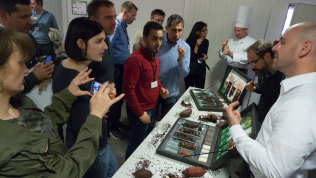Exploring the Cocoa Value Chain: from Production to Consumption

Nimmi Ariyaratne
Did you know that Switzerland has the highest consumption of chocolate in the world, at an estimated 12 kgs of chocolate per person annually? Demand for chocolate around the world is steadily increasing. However, supply of the essential ingredient for chocolate -quality cocoa beans- is endangered. Many cocoa supplying countries in Latin America and Africa face some of the same challenges:
- Degradation of soil quality and reduction in harvests due to monoculture,
- Low productivity and vulnerability of farmers: over 95% of cocoa is produced by small scale farmers who earn less than 1 dollar a day. They have little capital and are vulnerable to shocks such as natural disasters,
- Lack of quality control and technical know-how in the post-harvest processing of cocoa beans.
To address these concerns, SDC and
Chocolats Halba are trying an innovative partnership in Honduras to restart the cocoa value chain which never recovered after Hurricane Mitch in 1998. The objective of the project is to develop the cocoa value chain and improve the income of smallholder farmers in Honduras at the same time.
Nathalie Wyser Vizcarra explains Halba’s reason and approach:
The project directly impacts over 1300 small scale cocoa farmers in the country who are members of farmer cooperatives. The farmers receive the following key commitments from Halba:
- Long-term contracts providing a buy-back guarantee for up to 5 years,
- A fair price – current prices offered are 30% above world market prices,
- Premiums to invest in appropriate certification (such as fairtrade and organic certification),
- Capacity Building- training on good production and post-harvest processing techniques,
- Assistance for diversification of crops through agroforestry- this prevents soil degradation due to monoculture.
 Other stakeholders in this partnership include a local NGO (which provides organizational development trainings and access to finance to farmer cooperatives), sector coordination organizations which assist in steering the project, and research institutions (such as ETH) which provide technical support. Choosing the right partners, long term commitment from all stakeholders involved, understanding each other’s “languages” and concerns, and developing mutual trust between stakeholders are essential factors to make the collaboration between stakeholders work.
Other stakeholders in this partnership include a local NGO (which provides organizational development trainings and access to finance to farmer cooperatives), sector coordination organizations which assist in steering the project, and research institutions (such as ETH) which provide technical support. Choosing the right partners, long term commitment from all stakeholders involved, understanding each other’s “languages” and concerns, and developing mutual trust between stakeholders are essential factors to make the collaboration between stakeholders work.
This partnership meets the objectives of both SDC (fighting poverty) and Chocolats Halba (increasing profits- by securing supply sources of good quality cocoa for chocolate production in Switzerland). The income and productivity of farmers are improved. Ecological sustainability and food security of farmers are enhanced through agroforestry. Farmer cooperatives and also strengthened through the trainings received.
The cocoa beans produced through this partnership are exported directly to Switzerland, where Halba produces chocolate on a massive scale (over 12,000 tons of chocolate a year!) and sells the end product to consumers mainly through COOP- the second largest retailer in Switzerland.
What do participants take home from this visit?
Photo impressions:
